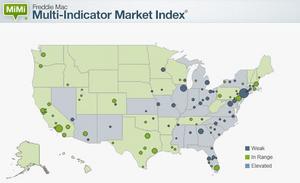 MCLEAN, VA--(Marketwired - Oct 23, 2015) - Freddie Mac (OTCQB: FMCC) today released its updated Multi-Indicator Market Index® (MiMi®) showing the U.S. housing market continuing to slowly stabilize with two additional metro areas entering their outer range of stable housing activity: Scranton and Harrisburg, Pennsylvania.
MCLEAN, VA--(Marketwired - Oct 23, 2015) - Freddie Mac (OTCQB: FMCC) today released its updated Multi-Indicator Market Index® (MiMi®) showing the U.S. housing market continuing to slowly stabilize with two additional metro areas entering their outer range of stable housing activity: Scranton and Harrisburg, Pennsylvania.
The national MiMi value stands at 81.2, indicating a housing market that is on its outer range of stable housing activity, while showing an improvement of +0.27% from July to August and a three-month improvement of +2.54%. On a year-over-year basis, the national MiMi value has improved +6.16%. Since its all-time low in October 2010, the national MiMi has rebounded 37%, but remains significantly off from its high of 121.7.
News Facts:
- Twenty-nine of the 50 states plus the District of Columbia have MiMi values in a stable range, with North Dakota (96.9), District of Columbia (103.9), Hawaii (93.5), Montana (93.2), and Utah (90.3) ranking in the top five.
- Forty-seven of the 100 metro areas have MiMi values in a stable range, with Fresno (99.4), Austin (96.6), Honolulu (94.1), Salt Lake City (93.3) and Los Angeles (93) ranking in the top five.
- The most improving states month-over-month were Ohio (+1.30%), South Carolina (+1.20%), New Jersey (+0.97%), Colorado (+0.92%) and Georgia (+0.83%). On a year-over-year basis, the most improving states were Florida (+14.07%), Oregon (+12.02%), Nevada (11.75%), Colorado (+11.28%), and Washington (+10.41%).
- The most improving metro areas month-over-month were Akron, OH (+1.47%), Palm Bay, FL (+1.28%), Cleveland, OH (+1.27%), Lakeland, FL (+1.26%) and Denver, CO (+1.21%). On a year-over-year basis, the most improving metro areas were Orlando, FL (+18.07%), Cape Coral, FL (+17.77%), Tampa, FL (+16.00%), Denver, CO (14.73) and Palm Bay, FL (+14.64%).
- In August, 48 of the 50 states and 98 of the top 100 metros were showing an improving three month trend. The same time last year, 35 of the 50 states plus the District of Columbia, and 71 of the top 100 metro areas were showing an improving three-month trend.
Quote attributable to Freddie Mac Deputy Chief Economist Len Kiefer:
"The nation's housing market continues to improve riding the wave of the best year in home sales since 2007. With the MiMi purchase applications indicator at its highest level in more than seven years we expect home sales to remain strong. Low mortgage rates are fueling the recovery across the country. Places like Denver, Austin and Salt Lake City, and most markets in California, are seeing robust home purchase demand and in many cases double-digit growth over last year."
"Buoyed by strong employment growth, housing supply is struggling to keep pace with demand, which is driving house prices higher. Fortunately, low mortgage interest rates are helping to keep homebuying affordable for some prospective homebuyers. Nationwide, housing markets are getting back to their long term benchmark averages, but they still have room for improvement. We're expecting housing to sustain its momentum going into yearend, but we're going to need stronger income growth to carry housing throughout 2016."
The 2015 MiMi release calendar is available online.
MiMi monitors and measures the stability of the nation's housing market, as well as the housing markets of all 50 states, the District of Columbia, and the top 100 metro markets. MiMi combines proprietary Freddie Mac data with current local market data to assess where each single-family housing market is relative to its own long-term stable range by looking at home purchase applications, payment-to-income ratios (changes in home purchasing power based on house prices, mortgage rates and household income), proportion of on-time mortgage payments in each market, and the local employment picture. The four indicators are combined to create a composite MiMi value for each market. Monthly, MiMi uses this data to show, at a glance, where each market stands relative to its own stable range of housing activity. MiMi also indicates how each market is trending, whether it is moving closer to, or further away from, its stable range. A market can fall outside its stable range by being too weak to generate enough demand for a well-balanced housing market or by overheating to an unsustainable level of activity.
For more detail on MiMi see the FAQs. The most current version can be found at FreddieMac.com/mimi.
Freddie Mac was established by Congress in 1970 to provide liquidity, stability and affordability to the nation's residential mortgage markets. Freddie Mac supports communities across the nation by providing mortgage capital to lenders. Today Freddie Mac is making home possible for approximately one in four home borrowers and is one of the largest sources of financing for multifamily housing. Additional information is available at FreddieMac.com, Twitter @FreddieMac and Freddie Mac's blog FreddieMac.com/blog.
The financial and other information contained in the documents that may be accessed on this page speaks only as of the date of those documents. The information could be out of date and no longer accurate. Freddie Mac does not undertake an obligation, and disclaims any duty, to update any of the information in those documents. Freddie Mac's future performance, including financial performance, is subject to various risks and uncertainties that could cause actual results to differ materially from expectations. The factors that could affect the company's future results are discussed more fully in our reports filed with the SEC.
